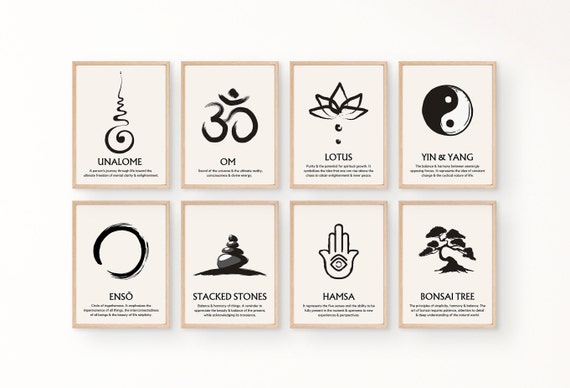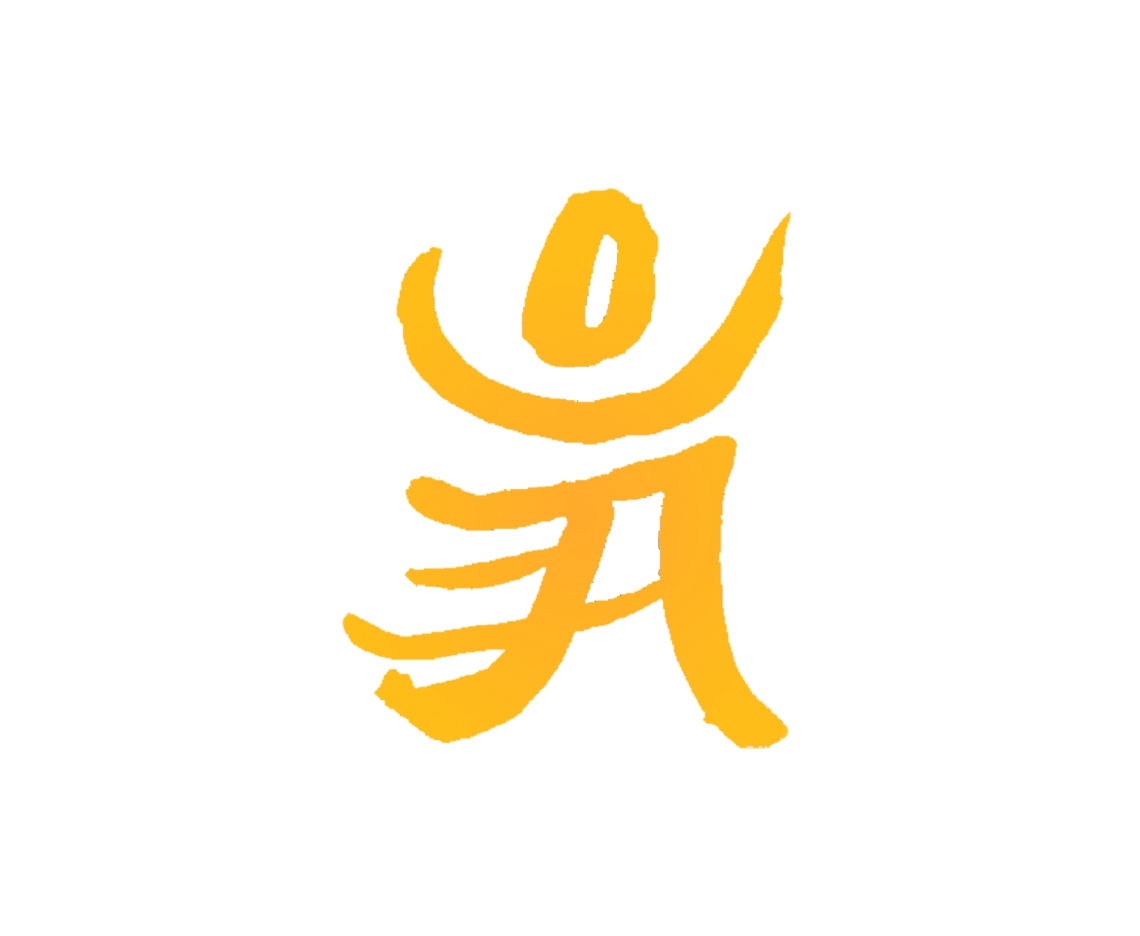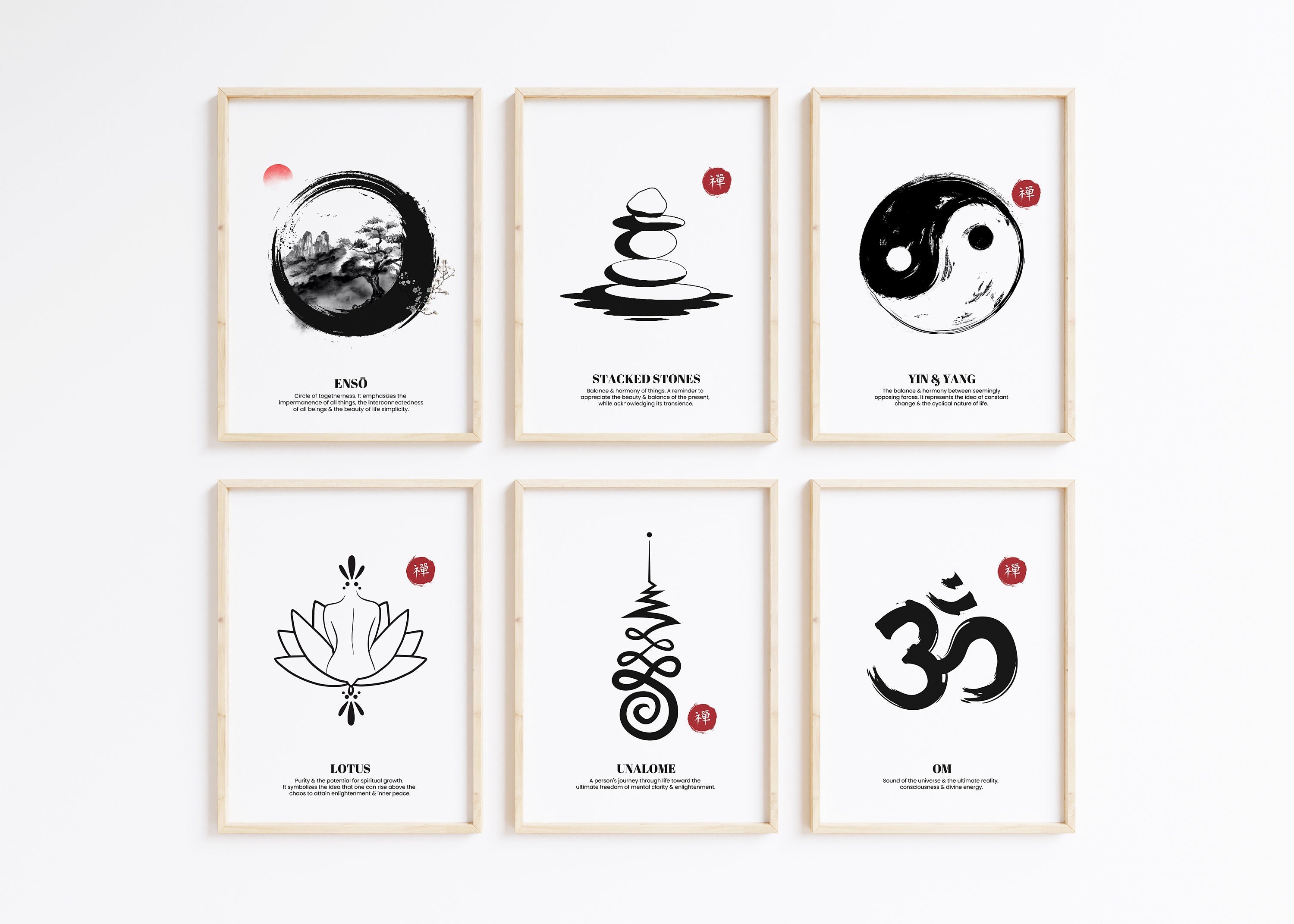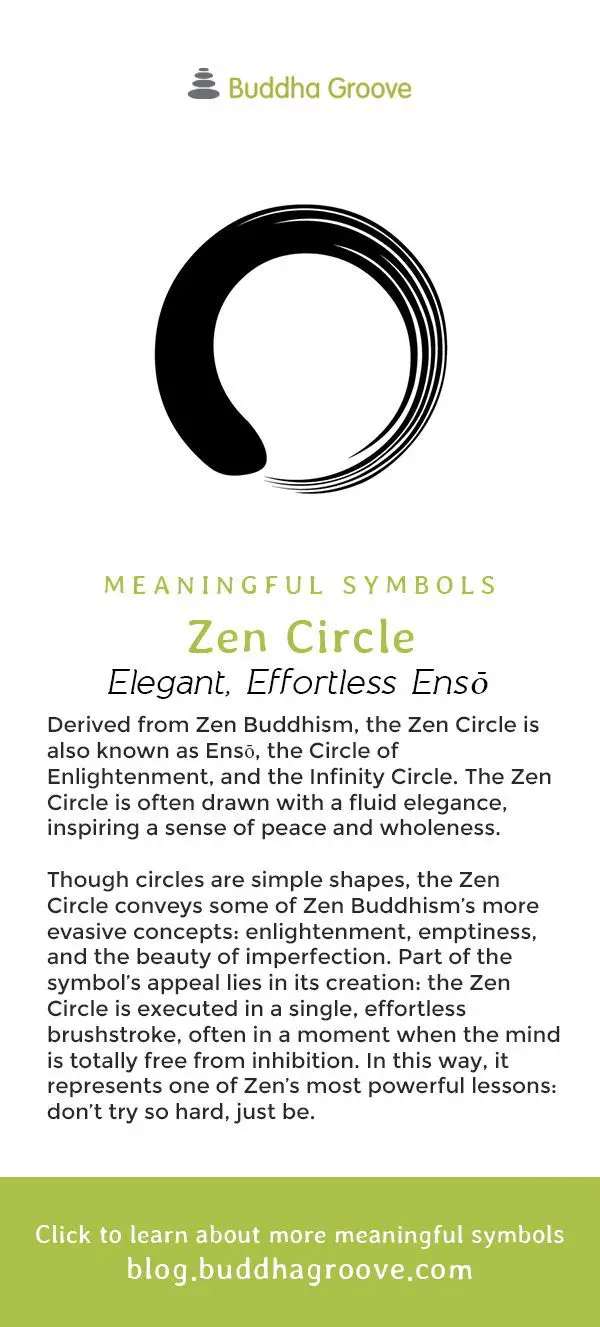Zen symbols, such as the ensō, represent enlightenment and the unity of the mind and body. These symbols hold deep spiritual significance in Zen Buddhism.
Many of these symbols originated in ancient Buddhist traditions and continue to hold meaning in modern Zen practices. Zen symbols are essential in conveying the profound concepts of Zen Buddhism. The ensō, a hand-drawn circle, represents the unity of the mind and body.
Other symbols, such as the throne and the swastika, carry historical and spiritual significance in the Buddhist tradition. Understanding these symbols provides insight into the rich spiritual heritage of Zen Buddhism. The enso, in particular, embodies the essence of enlightenment and the boundless nature of the spirit. It stands as a powerful reminder of the interconnectedness of all things and the pursuit of inner peace and enlightenment. As we delve into the meanings behind these symbols, we gain a deeper appreciation for the wisdom and spiritual depth of Zen Buddhism.
The Essence Of Zen
Zen is a philosophy and practice that originated in ancient China and was later adopted and developed in Japan. It is often associated with concepts of mindfulness, meditation, and the pursuit of inner peace. At the core of Zen is the belief in experiencing the present moment fully and letting go of attachments to past and future. In this blog post, we will explore the origins of Zen and its significance in modern culture.
Origins Of Zen
Zen traces its roots back to the teachings of Siddhartha Gautama, also known as the Buddha. The word “Zen” is derived from the Sanskrit word “dhyana,” which means meditation. Zen Buddhism emphasizes direct experience and insight, rather than relying on scriptures or intellectual understanding. It is a practice that encourages individuals to let go of conceptual thinking and directly perceive reality as it is.
In the 6th century, Zen Buddhism was introduced to China and became known as Chan Buddhism. The teachings of Chan masters, such as Bodhidharma and Huineng, emphasized meditation and direct transmission of wisdom from teacher to student. This approach attracted many followers who sought a more experiential and intuitive understanding of Buddhism.
Zen In Modern Culture
Today, Zen has a significant presence in modern culture, extending beyond its religious and philosophical origins. It has influenced various fields, including art, design, psychology, and mindfulness practices. Many people are drawn to Zen for its emphasis on simplicity, mindfulness, and finding inner peace amidst the chaos of daily life.
One of the most recognizable Zen symbols is the ensō, a hand-drawn circle that represents enlightenment and the interconnectedness of all things. The ensō is often created in a single brushstroke, symbolizing the spontaneous expression of the present moment. It is a reminder to embrace imperfection and to let go of the constant striving for perfection.
Another important Zen symbol is the lotus flower, which represents purity and spiritual awakening. Like the lotus, which grows from muddy waters and emerges unstained, Zen teachings emphasize the potential for transformation and liberation from suffering.
In modern culture, Zen principles are often incorporated into practices such as meditation, mindfulness, and minimalist living. Many people seek to incorporate these principles into their daily lives as a way to cultivate inner peace, reduce stress, and find balance amidst the demands of a fast-paced world.
Whether you are interested in exploring Zen as a spiritual practice or simply incorporating its principles into your daily life, understanding the origins and symbolism of Zen can deepen your appreciation for its timeless wisdom.
Symbols Of Serenity
Discover the profound meaning behind Zen symbols, including the sacred ensō circle. Representing enlightenment and the harmonious connection between mind and body, the ensō is hand-drawn in one or two brushstrokes, capturing the essence of Zen philosophy. Dive into the world of Zen symbolism and find serenity in its timeless wisdom.
Enso: The Circle Of Enlightenment
The enso, also known as “The Circle of Enlightenment,” is a sacred symbol in Zen Buddhism. It is a hand-drawn circle, typically created in one or two brushstrokes, representing a moment when the mind is free to let the body create. Some artists draw the enso as an open circle, while others complete the circle. This symbolizes the concept of imperfection and the continuous cycle of life.The Significance Of Simplicity
One of the key aspects of Zen symbols is their simplicity. Zen philosophy teaches that true serenity can be found in simplicity, as it allows the mind to focus and let go of distractions. The enso, with its minimalist design, embodies this principle perfectly. By using just a few brushstrokes, the enso captures the essence of Zen – the present moment, free from clutter and complexity.Buddhist Symbols Of Serenity
In addition to the enso, there are several other symbols in Buddhism that represent serenity and inner peace. These symbols have deep spiritual meanings and are often used in meditation and mindfulness practices. Here are a few examples:- The Bodhi Tree: A symbol of enlightenment, as it is believed that Buddha attained enlightenment while meditating under a bodhi tree.
- The Dharma Wheel: Represents the teachings of Buddha and the path to liberation from suffering.
- The Stupa: A sacred monument that symbolizes the Buddha’s physical presence and serves as a reminder of his teachings.
Emblems Of Enlightenment
Emblems of Enlightenment hold deep significance in Zen Buddhism, representing profound spiritual concepts and guiding principles. These symbols serve as powerful reminders of the path to enlightenment and are revered for their intrinsic meanings and representations. Let’s explore some of the most prominent emblems of enlightenment in Zen Buddhism.
The Ashtamangala: Eight Auspicious Symbols
The Ashtamangala, also known as the Eight Auspicious Symbols, holds immense spiritual significance in Buddhist traditions, including Zen Buddhism. These symbols are believed to have been offered by the gods to Shakyamuni Buddha upon his attainment of enlightenment. The Ashtamangala includes the throne, swastika, handprint, hooked knot, vase of jewels, water libation flask, pair of fishes, and lidded bowl, each symbolizing different aspects of the Buddha’s teachings and the path to enlightenment.
The Bodhi Tree, Dharma Wheel, And Stupa
The Bodhi Tree, Dharma Wheel, and Stupa are iconic emblems of enlightenment in Zen Buddhism. The Bodhi Tree is the sacred fig tree under which Siddhartha Gautama, the historical Buddha, achieved enlightenment. The Dharma Wheel symbolizes the teachings of the Buddha and the path to enlightenment, while the Stupa represents the enlightened mind and serves as a place of meditation and spiritual veneration. These emblems are revered for their profound symbolism and their role in guiding practitioners on the path to awakening.

Credit: www.etsy.com
Zen In Art And Practice
Zen Symbols Explained: Discover the profound meaning behind Zen symbols such as the ensō, a hand-drawn circle representing enlightenment, and the eight auspicious symbols of Buddhism, which symbolize offerings made by gods to the Buddha. Dive into the world of Japanese Zen and explore the enso, a symbol of infinite spirituality and transformation.
Zen in Art and Practice is a way of life that emphasizes simplicity, mindfulness, and living in the present moment. Zen symbols, such as the ensō and the lotus flower, play an important role in this practice by providing visual reminders of these values. In this article, we will explore the Zen aesthetic and how to incorporate Zen symbols into daily life.The Zen Aesthetic
The Zen aesthetic is characterized by simplicity, minimalism, and the use of natural materials. Zen art often features simple brushstrokes, muted colors, and a focus on negative space. The ensō, a circle drawn in one or two brushstrokes, is a classic Zen symbol that embodies the Zen aesthetic. The ensō represents the universe, the void, and the interconnectedness of all things. It is a reminder to live in the present moment and let go of attachments.Incorporating Zen Symbols In Daily Life
Incorporating Zen symbols into daily life can help cultivate mindfulness and a sense of calm. Here are some ways to do it:- Wear jewelry featuring Zen symbols, such as an ensō pendant or a lotus flower ring.
- Hang a calligraphy print of a Zen symbol, such as the ensō or the kanji for “mindfulness,” in your home or office.
- Use a lotus flower tea light holder or incense burner to create a peaceful atmosphere.
- Practice Zen meditation using a mala bracelet with 108 beads, each one representing a mantra or affirmation.
Sacred Geometry In Zen
Zen symbols are deeply rooted in sacred geometry, with the Enso symbolizing the circle of enlightenment in Zen philosophy. The Enso, drawn in one or two brushstrokes, represents a moment of free mind and body expression, signifying the infinite and transformative experience of enlightenment.
Sacred Geometry in Zen is an essential aspect of the practice. It is a visual representation of complex concepts that help practitioners understand and internalize them. One of the most prominent examples of Sacred Geometry in Zen is the mandala, a cosmic diagram that represents the universe and our place in it. Another symbol that is often misunderstood but has deep significance in Buddhism is the Swastika. In this blog post, we will explore these symbols in-depth, starting with the mandala.The Mandala: A Cosmic Diagram
The mandala is a Sanskrit word that means “circle.” It is a circular diagram that represents the universe and our place in it. In Zen, the mandala is used as a tool for meditation and is believed to help practitioners achieve enlightenment. The mandala is a complex symbol that is made up of various shapes and designs. The center of the mandala represents the self, and the outer rings represent the universe. The mandala is often used as a visual aid during meditation, and practitioners visualize themselves at the center of the mandala, surrounded by the universe.Understanding The Swastika In Buddhism
The Swastika is a symbol that has been used for thousands of years in various cultures around the world. In Buddhism, the Swastika is a symbol of good luck, prosperity, and long life. It is often used in temples and on Buddhist artifacts. However, the Swastika has also been used as a symbol of hate and oppression, particularly during World War II. It is essential to understand that the Swastika has a deep spiritual significance in Buddhism and should not be associated with its negative connotations in other contexts. In conclusion, Sacred Geometry in Zen is a fascinating and essential aspect of the practice. The mandala and Swastika are just two examples of the symbols used in Zen to represent complex concepts and aid in meditation. By understanding these symbols’ significance, practitioners can deepen their practice and achieve greater enlightenment.
Credit: www.buddhistsymbols.org
Tools For Meditation
Discover the profound meaning behind Zen symbols, such as the Enso, which represents a moment of artistic creation and freedom of the mind. These symbols serve as powerful tools for meditation, offering a deeper understanding of Zen philosophy and guiding practitioners towards inner peace and enlightenment.
Tools for Meditation Zen meditation is a spiritual practice that involves various tools to help individuals achieve a state of mental calmness and clarity. Some of the most commonly used tools for meditation in Zen include the Kesa and various symbols. The Kesa, which is a traditional Buddhist robe worn by Zen practitioners, plays an important role in Zen meditation. On the other hand, symbols such as the Enso, Bodhi tree, Dharma wheel, and stupa help individuals to focus their minds during meditation. The Role of the Kesa The Kesa is a simple, yet powerful tool that has been used in Zen meditation for centuries. This traditional robe is made from different pieces of cloth sewn together to form a rectangular shape. It is worn by Zen practitioners during meditation to help them focus their minds and stay present in the moment. The Kesa symbolizes the teachings of the Buddha and reminds practitioners of the need to cultivate wisdom and compassion. The Use of Symbolism in Zen Meditation Symbols play an important role in Zen meditation. They are used to help individuals focus their minds and achieve a state of mental calmness and clarity. Some of the most commonly used symbols in Zen include the Enso, Bodhi tree, Dharma wheel, and stupa. The Enso is one of the deepest symbols in Japanese Zen. It is a circle that is hand-drawn in one or two brushstrokes and represents the moment when the mind is free to let the body create. The Enso is a sacred symbol that is often referred to as “The Circle of Enlightenment.” The Bodhi tree is another important symbol in Zen meditation. It is the tree under which the Buddha achieved enlightenment and represents the importance of spiritual awakening. The Dharma wheel is a symbol that represents the teachings of the Buddha. It is a circular wheel with eight spokes and is used to remind practitioners of the need to cultivate wisdom and compassion. Lastly, the stupa is a symbol that represents the Buddha’s body, speech, and mind. It is a structure that is used to house relics of the Buddha and is believed to be a powerful tool for meditation. In conclusion, the Kesa and various symbols are important tools that are used in Zen meditation to help individuals achieve a state of mental calmness and clarity. They remind practitioners of the need to cultivate wisdom and compassion and help them stay present in the moment.Zen And The Natural World
Zen symbols, such as the Enso, hold deep meaning in the natural world. The Enso, a hand-drawn circle, represents a moment of enlightenment and the unity of the spiritual and physical. These symbols reflect the tranquility and harmony found in Zen philosophy, offering a timeless connection to nature.
Zen and the Natural World are closely intertwined, with Zen Buddhism emphasizing the importance of being present in the moment and attuned to the world around us. This is reflected in the use of natural motifs in Zen art and design, which often feature flora and water elements.Floral Motifs: The Lotus And Cherry Blossom
The lotus flower is a powerful symbol in Zen Buddhism, representing purity and enlightenment. It is often depicted in Zen art as a closed bud, symbolizing the potential for growth and transformation. As the lotus flower blooms and rises above the muddy waters, it represents the journey towards spiritual awakening. Similarly, the cherry blossom is a beloved symbol in Japanese culture, representing the fleeting nature of life and the beauty of impermanence. In Zen art, the cherry blossom is often depicted in full bloom or falling petals, reminding us to appreciate the present moment and let go of attachment.Water Elements: Symbolism Of Flow And Adaptability
Water is another important element in Zen symbolism, representing the fluidity of life and the ability to adapt and flow with change. In Zen art, water is often depicted in the form of waves or ripples, reminding us to be present and flexible in the face of life’s challenges. The koi fish, which is often depicted swimming upstream in Zen art, represents perseverance and determination. In Japanese culture, the koi is seen as a symbol of good luck and fortune, and is often associated with strength and courage. In conclusion, the natural world holds deep meaning and significance in Zen Buddhism. By incorporating natural motifs into art and design, Zen practitioners are reminded of the importance of being present, adaptable, and appreciative of the beauty that surrounds us.Transcending The Physical
In the realm of Zen, symbols serve as powerful tools for transcending the physical and tapping into the deeper realms of consciousness. These symbols go beyond their literal representations, offering profound insights and guiding individuals towards enlightenment. Let’s explore some of the key Zen symbols that point beyond themselves and delve into the enigmatic world of koans in Zen.
Symbols That Point Beyond Themselves
Zen symbols are rich in meaning and symbolism, often transcending their physical forms to convey deeper spiritual truths. From the enso symbol, representing the interconnectedness of life and the universe, to the lotus flower, symbolizing purity and enlightenment, each Zen symbol holds a profound significance that extends beyond its visual representation. These symbols serve as powerful reminders of the eternal truths and principles that underpin the Zen philosophy, guiding practitioners on their spiritual journey.
The Sound Of One Hand Clapping: Koans In Zen
Koans are enigmatic paradoxical statements or questions that defy rational understanding, often used in Zen practice to provoke transcendental insights. These seemingly nonsensical riddles are designed to push the mind beyond conventional thinking, leading to a direct experience of enlightenment. The famous “sound of one hand clapping” koan, for example, challenges the practitioner to transcend dualistic thinking and attain a state of profound realization. Through contemplating these koans, individuals are able to transcend the limitations of the rational mind and access deeper dimensions of awareness.
Zen Symbolism In Architecture
Zen symbolism in architecture utilizes sacred symbols such as the ensō, a hand-drawn circle representing enlightenment and the unity of the mind and body. These symbols are integrated into architectural designs to evoke a sense of calm and tranquility, reflecting the principles of Zen philosophy in physical spaces.
The Zen Garden: A Symbolic Landscape
The Zen garden, also known as a Japanese rock garden or dry landscape garden, is a key element in Zen architecture. It is designed to create a sense of tranquility and harmony, reflecting the principles of Zen Buddhism. The garden typically consists of carefully arranged rocks, gravel or sand, and minimal vegetation. Each element in the garden holds symbolic meaning, contributing to the overall Zen experience.
Some key symbols found in Zen gardens include:
- Rocks: The rocks in the garden represent mountains or islands and are strategically placed to create a balanced composition. They symbolize strength, stability, and the enduring nature of enlightenment.
- Gravel or Sand: The raked patterns in the gravel or sand symbolize the flow of water, creating a sense of movement and tranquility. They also represent the impermanence of life and the ever-changing nature of existence.
- Vegetation: Minimal vegetation, such as moss or small shrubs, is carefully chosen and positioned to complement the rocks and create a sense of harmony. It represents the beauty of nature and the interconnectedness of all living beings.
Architecture Of Monasteries And Temples
Zen monasteries and temples are architectural marvels that embody the principles of Zen Buddhism. The design and layout of these sacred spaces are carefully planned to create an environment conducive to meditation and spiritual practice. Here are some key features of Zen architecture:
- Simplicity: Zen architecture follows the principle of simplicity, with clean lines, minimalist aesthetics, and a focus on natural materials such as wood and stone. This simplicity helps to create a sense of calm and allows the mind to focus on the present moment.
- Harmony with Nature: Zen architecture seamlessly integrates with the surrounding natural environment. It often includes elements such as gardens, ponds, and open courtyards, blurring the boundaries between indoor and outdoor spaces. This harmonious integration promotes a deep connection with nature and a sense of interconnectedness.
- Balance and Proportion: Zen architecture emphasizes balance and proportion in its design. It follows the principles of traditional Japanese aesthetics, such as the golden ratio and the concept of wabi-sabi, embracing imperfections and the beauty of simplicity.
Whether it’s the symbolic landscape of a Zen garden or the serene architecture of a monastery, Zen symbolism in architecture serves as a visual representation of the core principles of Zen Buddhism. It invites us to embrace simplicity, find harmony in nature, and cultivate a sense of peace and mindfulness in our lives.

Credit: www.etsy.com
Frequently Asked Questions
What Do The Symbols Of Zen Mean?
The symbols of Zen have deep meanings. The ensō, a hand-drawn circle, represents the moment when the mind is free to create. It symbolizes enlightenment. Other symbols in Zen Buddhism include the Bodhi tree, the Dharma wheel, and the stupa, which represent important aspects of the Buddhist faith.
These symbols hold spiritual significance and are revered in Zen culture.
What Do The 8 Symbols Of Buddhism Mean?
The eight symbols of Buddhism have significant meanings. One of them is the ensō, a circle that represents enlightenment. Other symbols include the throne, swastika, handprint, hooked knot, vase of jewels, water libation flask, pair of fishes, and lidded bowl.
These symbols represent the offerings made by gods to Buddha after gaining enlightenment.
What Are The Top Three Buddhist Symbols?
The top three Buddhist symbols are the Bodhi tree, the Dharma wheel, and the stupa. These symbols hold significant meaning in Buddhism and are frequently found at major Buddhist sites. The Bodhi tree represents the place where Siddhartha Gautama, the historical Buddha, attained enlightenment.
The Dharma wheel symbolizes the teachings of the Buddha, while the stupa represents the burial mound or shrine where relics of the Buddha or other revered figures are kept. These symbols are central to Buddhist practice and belief.
What Are The 3 Characteristics Of Zen?
The three characteristics of Zen are simplicity, mindfulness, and being in the present moment.
Faq 1: What Is The Meaning Of The Zen Symbol, Ensō?
Ensō is a sacred symbol in Zen Buddhism, often referred to as “The Circle of Enlightenment. ” It represents a moment when the mind is free to let the body create and is hand-drawn in one or two brushstrokes. Some artists draw an open circle, while others complete the circle.
Conclusion
Zen symbols hold deep spiritual meanings and are widely used in Zen Buddhism. Understanding the significance of these symbols can lead to a greater appreciation of Zen philosophy and practices. From the enso to the eight symbols of good fortune, each symbol conveys a unique message of enlightenment and inner peace.

